If you hear the call of the wild where there are more bears than signal bars, this article is for you. Twenty-eight fellow truck campers share where they go, how they prepare, and what happens when you go truck camping beyond cell service.
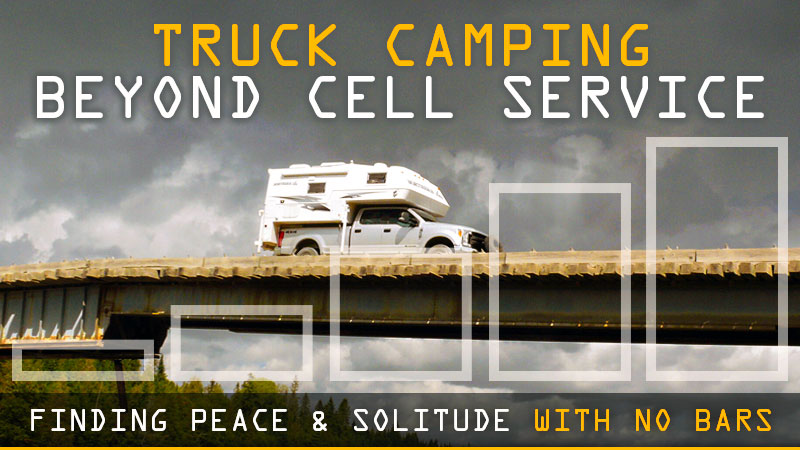
Three important themes emerged from the following responses to our recent question, “Do you truck camp beyond cell service?”. First, the need to be prepared and self-sufficient before setting out beyond cell service. Second, the need to tell your friends and/or family exactly where you are going and when you should return. And third, the recommendation to take a satellite messenger device in case something goes wrong.
Another interesting sub-theme surfaced on the different perceptions of not having cell service. For example, some people live in more rural areas where cell service is spotty. Others live in more urban areas where cell service is ubiquitous and taken for granted. For the first group, being beyond cell service is a normal experience making our question practically ridiculous. For the second, the idea of not having a cell signal is becoming increasingly foreign.
In our truck camping travels, we have found reliable cell signals to be increasingly difficult to shake. Even in areas where no signal was previously available, now it is, and with cellular internet to boot. That means going beyond cell signal requires being in particularly remote areas even further from the reaches of civilization.
That’s why we framed the question the way we did. To be beyond cell service is perhaps one of the best objective measures that you’re really out there. Or, as a friend in Wyoming is sure to remind me, just living in a small town out west and driving down the road a piece.
We had a first-generation SPOT Satellite Messenger back in 2008. The product was the first of its kind; a portable satellite messenger that used GPS satellites to locate your position anywhere on Earth and send that information to anyone you selected via email and Google Maps. It also had an emergency 9-1-1 button that connected to an Emergency Response Center so you could get help instead of freezing to death or being eaten by wolves.
Our SPOT was mostly used to ping our friends and family with our location as we traveled. With the magazine, we couldn’t be beyond cell service for too long, and we were fortunate to not trip over a rock or rattlesnake when we did. It was amazing to experience how the SPOT device was able to send our location to a satellite and then pin that location to Google Maps online. As a society, we have become accustomed to such incredible feats of engineering and technology, but this was something to behold.
Fourteen years later, SPOT has significantly improved its hardware, and a number of major competitors have emerged. Among the respondents, the Garmin inReach series is by far the most popular. After a bit of research, we are now looking at the compact Garmin inReach Mini 2. If you’re the kind of truck camper who enjoys traveling off-road, off-grid and beyond cell service, such a device is well worth looking into.
Twenty-eight fellow truck campers share where they go, how they prepare, and what happens when you go truck camping beyond cell service. Can you hear me now? No? Good! Lets’ go truck camping.
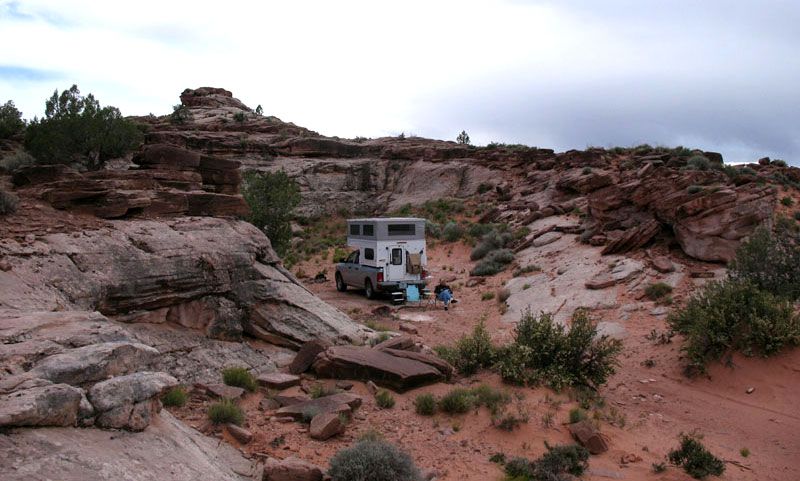
Above: South of Big Water, Utah
“This little cul-de-sac south of Big Water, Utah that’s near the Arizona border is protected from the wind and defines private. We were in the area at the end of the day and had just been to the Bureau of Land Management Visitor Center in Big Water. We went exploring, found this location, and liked it well enough to spend three nights.
We keep our rig ready to go at all times but, in this particular case, we were at the start of a two-week trip to southern Utah. We are fanatics about preventative maintenance and always have our mechanic check over the truck’s major systems prior to a long trip. Before going to this site, be sure your truck is in good shape, especially the tires.
We rarely use a cell phone, but do carry a SPOT satellite tracking device for a real emergency. We really like being able to camp in a site for, say three or four days, and never see or hear another party. ” – Kurt Herzog, 2018 Ram 1500, 2018 Phoenix Custom pop-up
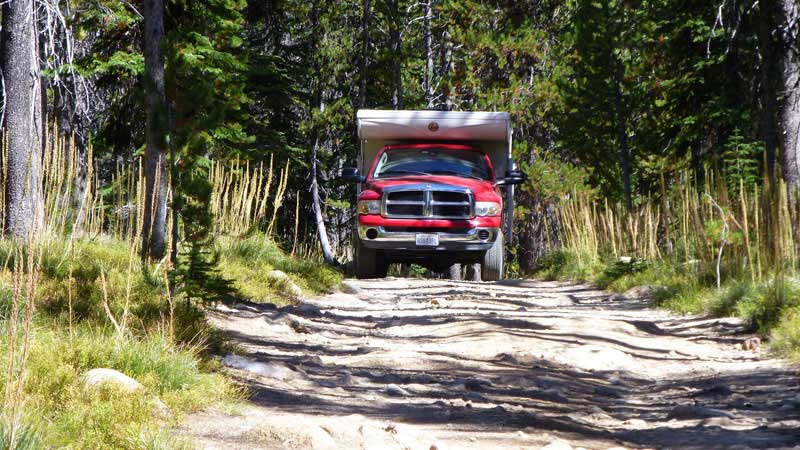
Above: Magruder Corridor in Idaho
“There are hundreds or thousands of places in the western United States, especially in Idaho, Wyoming, Utah, Oregon, Montana, and Nevada, where cell service is non-existent. Just pick a spot without cell service on your carrier’s map and go there. Mountain topography usually plays a big role.
We primarily go for peace and quiet. Why go to a wonderful natural place to stare at a cell phone screen all day? Turn the cell phone off and enjoy the natural environment.
“Why go to a wonderful natural place to stare at a cell phone screen all day?”
My rig is ready to go regardless if I have cell service or not. My mindset is to be prepared for most contingencies. Flat tires are common, so have good tires on your rig and know how to change a flat. Also, know how to fix small issues with your camper. I also recommend that you are prepared with food, water, and tools. Keep your rig in perfect mechanical condition at all times.
We go back for peace and quiet, and the remoteness.” – Donald Hanley, 2005 Dodge Ram 2500, 2009 Hallmark Guanella, read more about Don in his article Ten Challenging Backroads
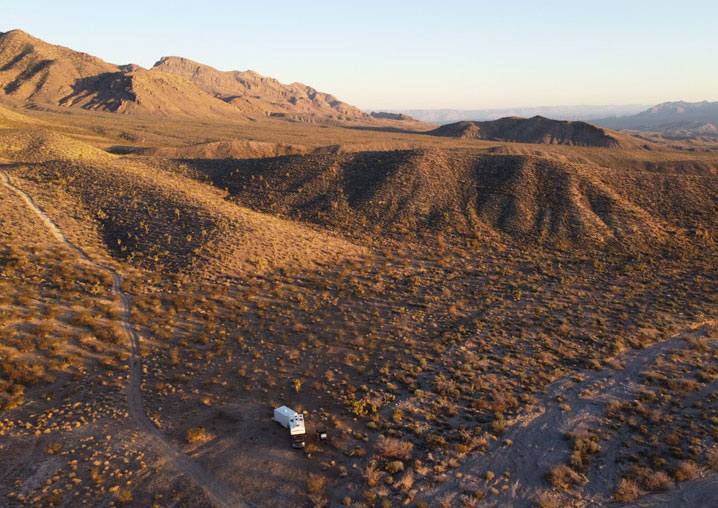
Above: Gold Butte National Monument, Nevada
“There are some remote desert spots with no cell service over broad areas. Much more common are campsites at the bottom of tight mountain valleys with no cell service. In those places, you might drive uphill a bit or to the canyon mouth and have good service, but nothing in that prime spot along the creek.
We are not social campers. Our ideal spot is one from which we can see no artificial light of any kind at night. It’s kind of a minimum requirement (unless we’re traveling on a tight schedule or visiting a destination location) that we are out of sight of other campers. And out of earshot, for sure.
We have a WeBoost Reach Drive RV cell phone booster. It’s carefully installed to get the antenna (on a folding mast) and the amplifier as far apart as possible for maximum performance. This set-up often produces a useable signal where the phones alone showed no service.
Beyond that, there is great peace of mind in carrying a satellite communication device. For example, Garmin InReach, SPOT, ZOLEO (which is what we use) or other. Service plans vary in cost, but the most basic ones will call in the calvary at the push of a button literally anywhere on Earth with a view of the sky.
The ability to reach us in an emergency (the ZOLEO plan we use allows us to receive texts, no matter how remote our location) allows us to camp far from the crowds with much less worry about my aging dad.
“When I can go outside at night and turn in a slow circle, surveying a thousand acres around me and not see a rig, light or soul, I feel peaceful and incredibly fortunate.”
You can control some of the risks with common sense. Turn around before you get in trouble. Carry enough tools and spare parts to do whatever minor repairs you’re competent to do. Keep up on maintenance to ensure maximum possible reliability. And then accept that you are assuming some increased level of possibility that you might have to call for help and that doing so might be quite expensive.
When I can go outside at night and turn in a slow circle, surveying a thousand acres around me and not see a rig, light or soul, I feel peaceful and incredibly fortunate.” – Scott Ellis, 2012 Chevy 3500, 2019 Northern Lite 9-6QSE
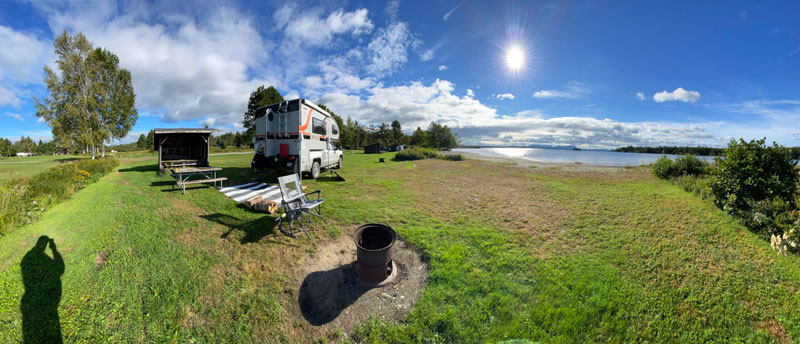
Above: Seboomook Wilderness Campground, Seboomook Township, Maine
“I like to go to the Seboomook Wilderness Campground in Seboomook Lake Township in Maine. The campsites are right on Moosehead Lake and there’s lots of wildlife. There’s no cell service. I was seeking solitude and I found it.
If you go, make sure you have a way to change, plug, and fill tires. Old logging/forest roads that are privately owned by the logging companies get shut down for repairs with zero notice. I also brought my portable solar panels and made sure I had an extra tank of propane.
During my stay, I cooked the best Cast Iron skillet steak over coals that I’ve ever had in my life. I still can’t replicate it. The peace and quiet of Seboomook Wilderness Campground calls me back. It was an amazing experience and I can’t wait to return.” – Riley Mitchell, 2015 Silverado 3500, 2016 Cirrus 800
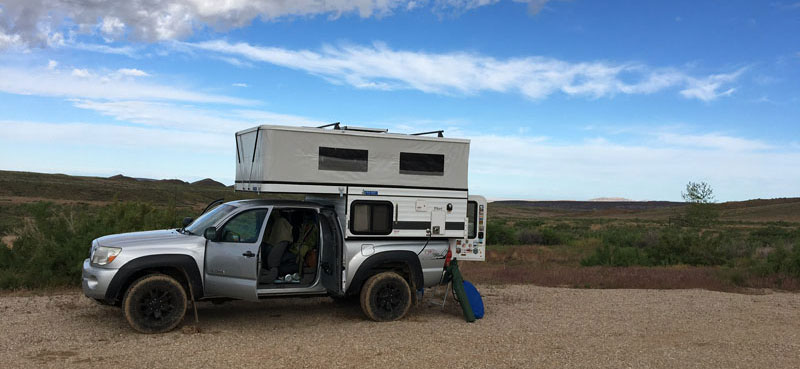
Above: Red Gulch Dinosaur Tracksite, near Shell, Wyoming
“I go to southeast Utah; Bears Ears and Grand Gulch. I generally prefer areas that are low and secluded. I also enjoy the Bighorn Mountains.
In the past couple of years, cell service has expanded and can be found in surprisingly remote areas. Scope out the weather when you do have cell service. And know your limits, especially time.
We go back for seclusion, quiet, and to be away from generators. We go mostly hiking. My Tacoma with a Four Wheel Camper Fleet camper has solar for our refrigerator. We always carry extra water.
Taking a Scenic Backroads in Wyoming, we encountered a late afternoon downpour that made the single-lane road too slick to drive. Fortunately, we were able to return a short distance to a graveled parking area to spend the night. It turned out to be a great site, only us and meadowlarks. I’m glad the road dried out because scenic backroads can be a real adventure.” – Michael Kinnee, 2008 Toyota Tacoma TRD, Four Wheel Camper Fleet
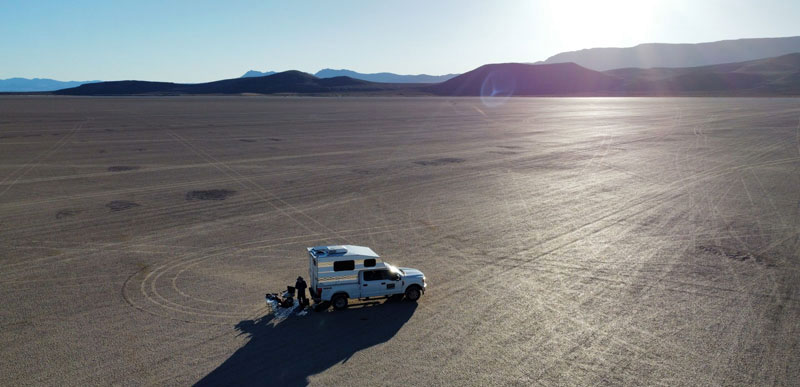
Above: Alvord Desert, Oregon
“Cell service? What cell service? We can’t think of many places we’ve camped with any reception. If so, it’s just a bar to squeeze out a text if you’re lucky.
To name a few places: Big Bend Ranch State Park at Guale II, Coronado National Forest Montezuma Canyon on the Mexico border, Picante National Preserve in Sorona, Mexico, Alvord Desert in Oregon, Sunlight Basin off of the Chief Joseph Highway in Wyoming, and the Wind River Range camping on the Green River in Wyoming.
We love to be remote. There’s something about the outback wilderness that draws us in. We always need to find out what is around the next bend. To camp and not see or hear anyone else is a treat for us.
We specifically kept our rig as simple as possible so less could go wrong. We have a 175-watt Renogy solar panel that keeps our fridge running and two deep cell batteries charged up. No grey water to freeze; only a hand pump sink. We can stay off-the-grid indefinitely if we camp near a water source. We have a Dickinson propane fireplace to warm the camper at night and in the morning, but never run it while we sleep.
“It’s all about that moment when you have found this amazing place that takes your breath away.”
Other than a few close calls with getting stuck, we have not had anything but great memories and remote landscapes.
Always let someone know where you are headed while you have cell service. Take enough food and water to last a few days if things go wrong. Have chlorinating tablets for water if needed. Never leave without a good detailed map of the area you will be in. We always carry the Benchmark Maps for the states we are traveling. Carry the tools needed to help you out of unforeseen problems. We carry a tow strap, air compressor, battery-powered chain saw, and traction mat. Although we don’t use one, there are plenty of GPS emergency devices that can be used if you feel safer with one.
It’s all about that moment when you have found this amazing place that takes your breath away. No sight of civilization for miles, complete silence except for the wind and water, coyotes in the evening and elk in the morning.” – Marcus Larson, 2019 Ford F-250, 2019 Capri Retreat, read more about Marcus and Cindy in their article Dream Big with a Small Rig
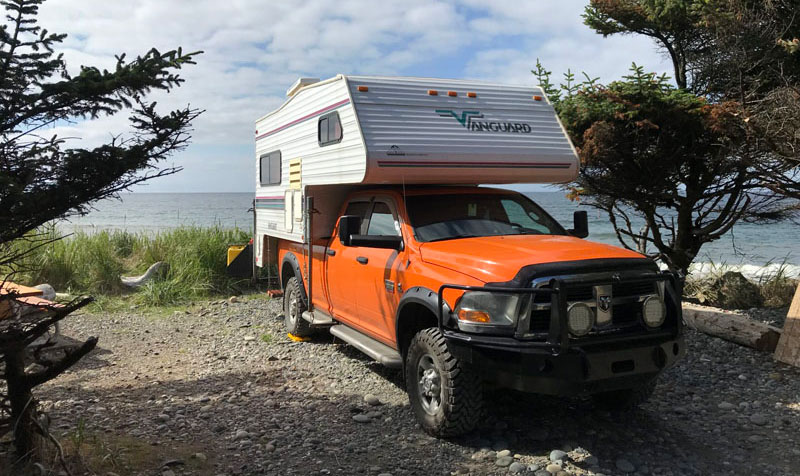
Above: Haida Gwaii, former Princess Charlotte Island
“We have taken our truck camper on multiple trips in the Canadian Rockies where there is no cell service beyond the towns of Jasper or Banff. We go for hikes or just relax in boondocking campgrounds. We were traveled beyond cell service on our trip to Haida Gwaii. What is nicer than being parked on the beach with no cell service?
We never plan much. We just have a global idea of where to go. Sometimes we see articles from other travelers or hikers that look nice and take that as a beginning point. Or we just look at the map and say, “Let’s go that way and explore.”
“What is nicer than being parked on the beach with no cell service?”
We have our truck always in top condition, especially if we go to remote places. We have installed bigger mud-terrain tires on steel rims. We have extra fuel cans and solar. The camper is pretty much stock except for the inverter so we can make a real cappuccino.
One day we were boondocking early in the season in the Rockies and were cooking some steaks on the barbecue. When we were having supper in the camper, my wife was telling me that it would be something if a bear came to see what all that smell was about. It was as if a bear was listening because, within 30-seconds, a black bear was creeping out of the bush. When I closed the door the bear got spooked by the noise and ran off.
Make sure you have your vehicle in good condition and always fill your fuel and water tanks. Drive slow and careful. It’s not a race. It’s easy to break something so always think ahead. Bring paper maps and a compass, and know how to use them.
When you are beyond cell service you always have the best views. It’s quiet and you really go back to nature. There are no distractions.” – Martien and Roeby Brand, 2011 Ram 3500, 1998 Vanguard C90
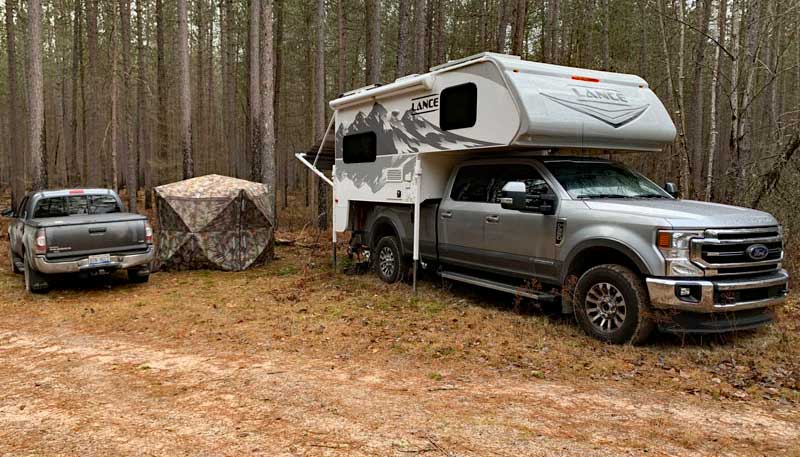
Above: Michigan’s Upper Peninsula
“I go on an annual trip to the edge of wilderness area in Michigan’s Upper Peninsula. I hike in and fish for steelhead trout in April. The snow is nearly melted off and the nights are cold.
My recommendation is to carry a Garmin In-Reach Mini when off-grid. This device has dramatically changed my off-grid travels. My wife worries less and I can be reached in an emergency if needed.
The rig is ready to go. I just need to bring a pole saw to cut low branches to get back closer to the river. It’s so simple to pull in, level up, and go fishing. We fish regardless of the weather, so having a dry warm place to come back to, close to the river is so nice.” – Tim DeHart, 2021 Ford, F-350, 2021 Lance 850
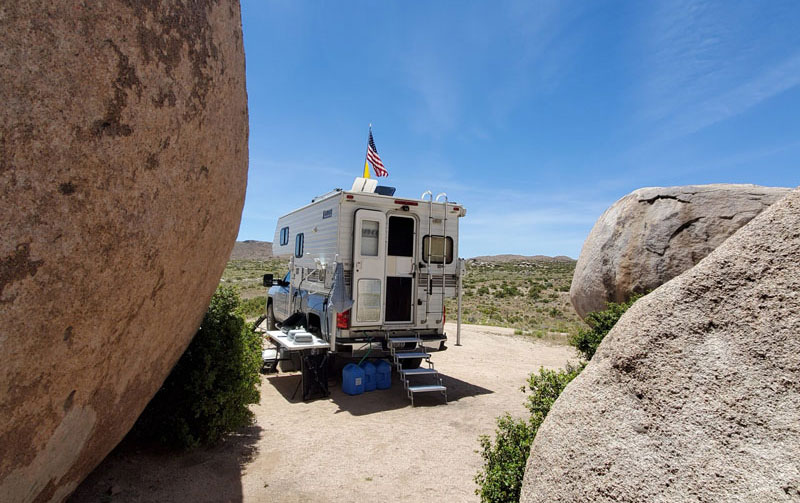
Above: Mojave Preserve
“I like to go to Behind the Rocks in the Mojave Preserve as well as near the waters of Lake Mead. I go to these locations for peace and quiet and a retreat from the noise of society.
To prepare my rig, I just add water and food. Other than a bee sting and a visit from a harmless snake, everything was absolutely peaceful in the Mojave Preserve. We had a big wind storm at Lake Mead that sent us home a day early. Other than the wind, everything was perfect. ” – Clifford Craft, 2017 Chevy 2500HD, 2007 Lance 815
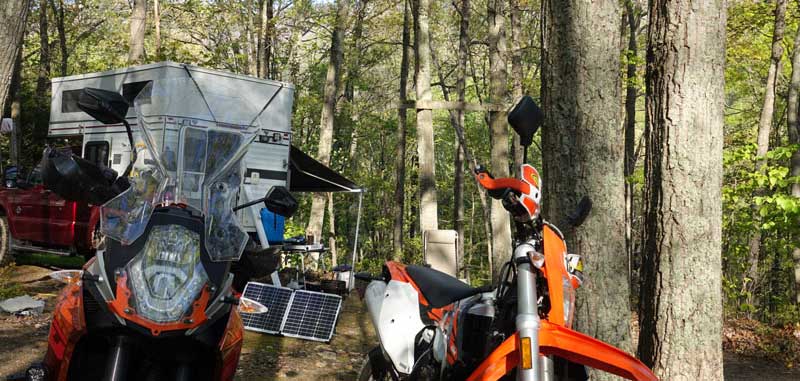
Above: West Virginia
“I have camped in many places around the United States without cell service. Most commonly, West Virginia, near Dolly Sods. I camp at the top of a friend’s property with the river below. It’s a steep hike up and down, but worth it. There is no cell service and no people; just perfect.
Number one is the peaceful feeling of being in the woods alone with basically no contact with the outside world. I always keep my Garmin InReach for emergencies. I have been all over the US and, for the East Coast, West Virginia has some of the prettiest mountains around; lots of rocky jagged edges with the crystal-clear river below. My friend’s property is only three-hours from my house and is privately owned.
I have set my rig up for overlanding and bugging out. I have tools, supplies, and emergency gear. I could easily live in it for many weeks without a problem.
“What draws me back is living alone in the woods. The peace and quiet. The need to improvise. The connection with the land… it’s why we all go.”
Going up the steep trek from the river to my campsite, I once got my KTM 350-EXC dual-sport bike stuck. It was too steep for my on-road off-road tires. It was wet and rocky so I just couldn’t get past a certain point by a switchback in the trail. Three-hours later with some digging, MaxTrax, and a large come-along, I made it out. New tires next time.
I recommend investing in an emergency communicator like a Garmin InReach. You never know.
What draws me back is living alone in the woods. The peace and quiet. The need to improvise. The connection with the land… it’s why we all go.” – Scott Henry, 2016 Ford F-350, 2016 Four Wheel Camper Hawk
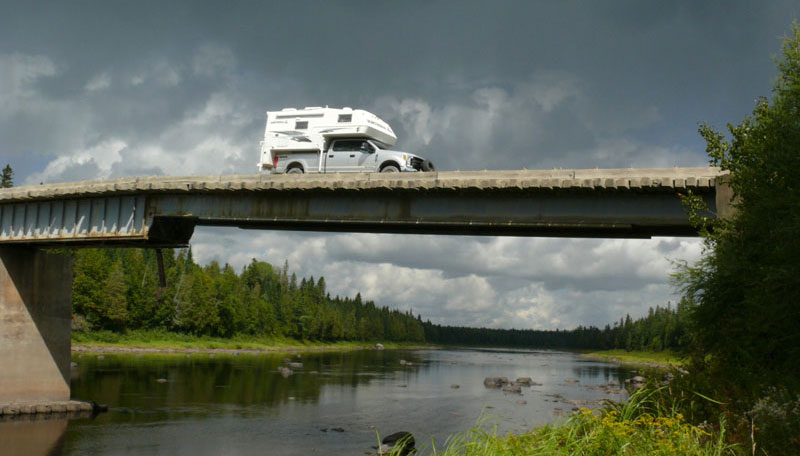
Above: Blanchet Bridge over the St. John River on the way to St. Pamphile, Quebec
“We spend most of our camping in remote areas of Maine, Quebec, Labrador, and Newfoundland. We do have a Garmin InReach if we need to send a message. We live on the fringe of no cell service, so not having any while camping is not an issue.
We like to fish remote water for brook trout and salmon. We really enjoy being alone in beautiful places. We also enjoy grouse hunting in the same areas. Walking and hiking in these areas are very interesting.
We spend a lot of time in remote areas and are well equipped to handle most issues. We carry a good selection of tools, an air compressor, spare parts, and a winch. We have been fortunate to be able to handle everything we’ve encountered so far.
Ten-ply tires are a must. Gravel is hard on tires. I also recommend an air compressor, a Safety Seal tire plug kit, and a tool kit that will enable you to tackle the larger size nuts and bolts on your truck. You should also carry spare filters and oil. Two spare tires might be a good idea as well as a Hi-Lift jack, winch, or at least a two-ton hand winch.
We carry blocks of wood to use as jack points/stands. Flat rocks are not always easy to find. A chain saw is handy, but a good hand saw, axe/cant dog (a logging tool) are essential. You should have a round point shovel and a ground tarp to lay on or use as cover. Working in the rain and snow is not fun.
We live remote and enjoy being more remote when we have time off.” – John Tatko, 2017 F350, 2018 Northern Lite 9-6Q SE
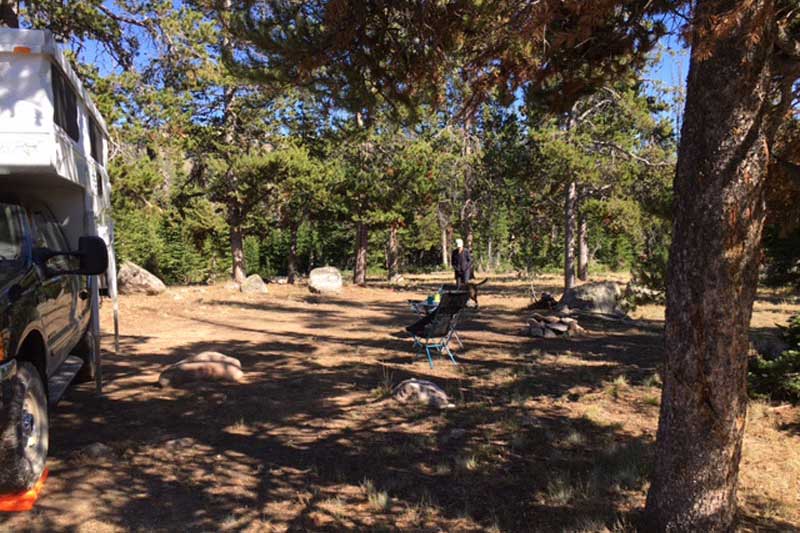
Above: Bighorn National Forest
“I go to the Bighorn National Forest in Wyoming and the Superior National Forest and nearby state forests in Minnesota. I’ve been going to the Bighorns in Wyoming since the mid-1970s and I enjoy it there. I live in Minnesota and love to use my camper for grouse hunting.
My truck and camper are always set up to take care of myself. I did not need a cell phone for most of my camping life. I do not worry about going off-grid to do what I want.
“I enjoy going to these places because I do not have to look at all the awning lights and garbage everyone brings to a campground. I also do not have to listen to someone start a generator in the morning.”
Last fall while hunting in a state forest in northern Minnesota, I found a gentleman in a pickup with two flat tires. He was over 30-miles from any services and there was no cell signal. My wife and I helped him change the completely flat tire and told him how to get where we were camped. He arrived at our camp with six-pounds of air in his leaking tire. I plugged both tires, filled them to the correct pressure, and sent him on his way.
My wife said, “How long have we had that compressor and patch kit in the camper?” I answered, “Since our first trip in 2001”. My advice is what I learned as an Eagle Scout; Be Prepared.
I enjoy going to these places because I do not have to look at all the awning lights and garbage everyone brings to a campground. I also do not have to listen to someone start a generator in the morning to make coffee with an electric drip coffee maker.” – Lou Buesseler, 2000 F-250, 2016 Northstar SC850
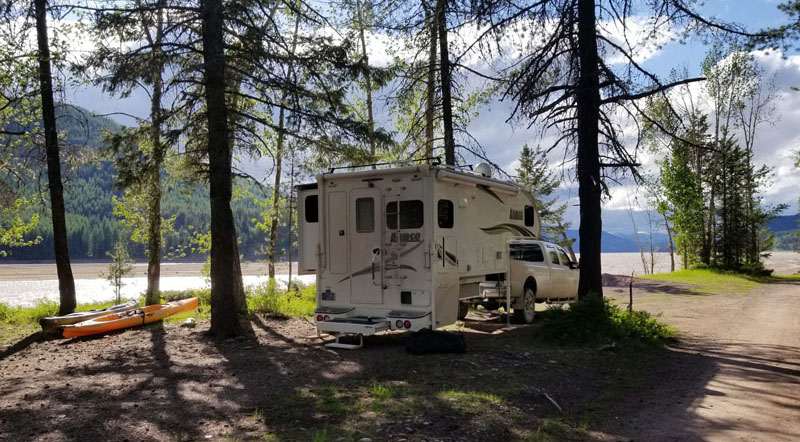
Above: Montana – 50 miles (2-hour drive) from civilization, 4×4 required
“That’s why we bought a truck camper in the first place! To go where no phone works for days. We love the outdoors, so the more remote the better. Of course, a few modern conveniences are provided by our truck camper.
We live in Montana. We normally camp on dispersed sites in the mountains or near a lake. Most journeys entail at least an hour drive of about 40-miles, but it’s over dirt forest roads that are not well maintained, and are not for the faint of heart. We normally won’t see another human being until we are back to civilization.
We have also camped beyond cell phone signal in Michigan (west, east, and the Upper Peninsula), Wisconsin, Idaho, North Dakota, South Dakota, Wyoming, Pennsylvania, and Ohio.
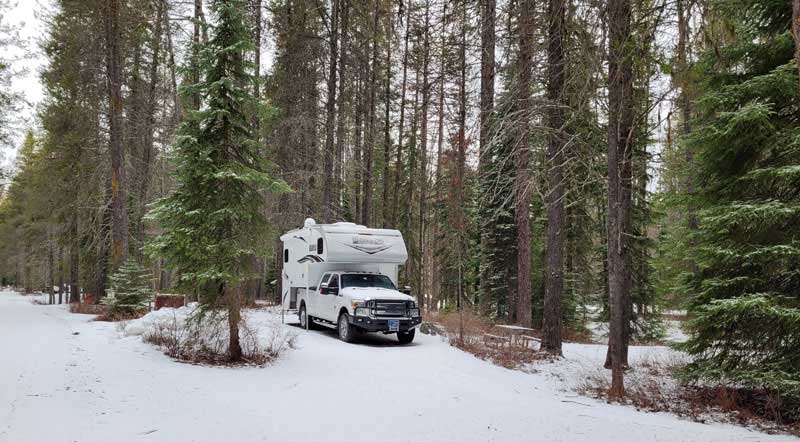
We have always been drawn to the solitude of nature and the environment. It makes you appreciate how small we humans really are, and how caught up society is with the hustle and bustle. It allows us to appreciate what we have, who we have, where we are, and this great place we found to enjoy for a few days.
“It allows us to appreciate what we have, who we have, where we are, and this great place we found to enjoy for a few days.”
On every new adventure, where our phone stops working for days is amazing. We hike, fish, hunt, explore old forest roads, backpack, bike, off-road, and boat (float or power) all from the comfortable base camp of our truck camper.
We have a Lance 975 and it sits on an F-350 Diesel with 10-ply tires. It came solar and four-season ready. We added more solar panels, upgraded the solar control unit, a 3,000-watt pure sine wave inverter, and switched to 300-amp hour Lithium batteries. All of this was so that we can camp in peace and quiet for days on end, without the hum of a generator.
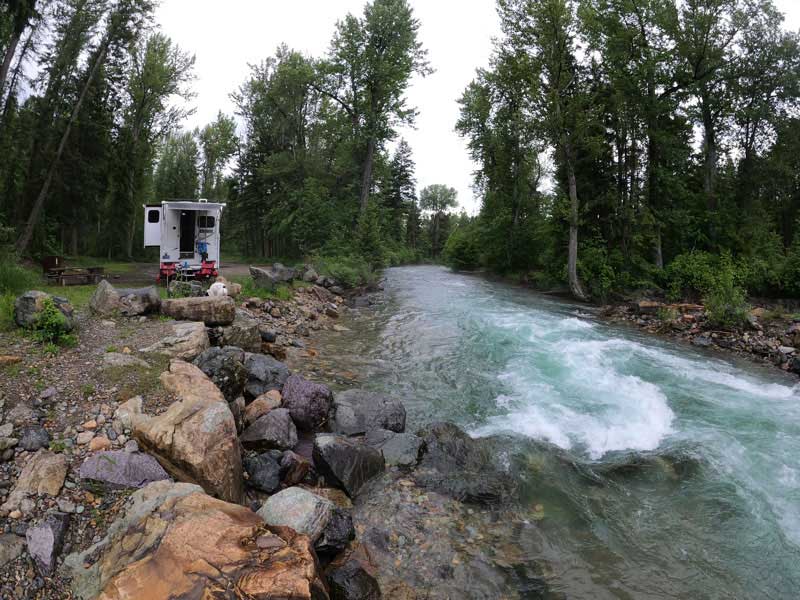
Our remote experiences have varied over the years, but we have remote experiences almost weekly. So there are always stories about animals or weather or blocked roads or injuries (none have been life-threatening). The list goes on. It’s fun to share these experiences with friends and family when they visit.
We have learned from the school of hard knocks, but we always take a satellite communicator with an emergency button. We let people know where we are going and our tentative timeline. We always have a spare part for important pieces of equipment. We learned this last tip from winter camping when our furnace kept shutting off and the hot water heater stopped working. So, we keep spare motherboards, sails switches, etc.
We also carry a good first aid kit tailored to our needs. If you can, take AED, first aid, and CPR classes. And even better, take wilderness first aid classes. Fill up all your tanks and have water treatment or filter kits. A CB radio for narrow forest roads that are frequented by logging trucks is another good idea.” – Jeff and Ali Knowles, 2013 Ford F350, 2019 Lance 975
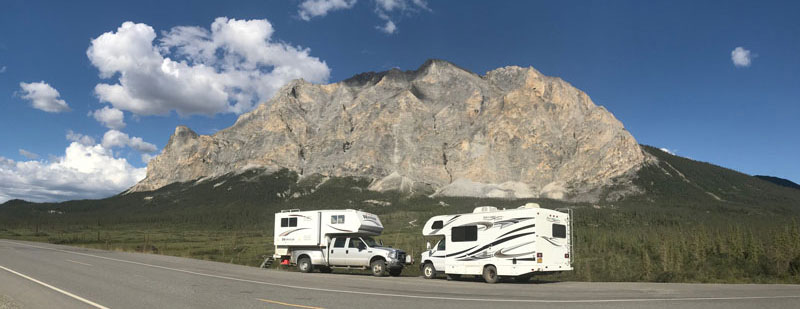
Above: Camping on mile 203 on Dalton Highway way beyond cell service. Mt. Sukakpak in the background.
“Most areas we camp here in Alaska are beyond cell service. Our camping would be very limited if we stuck to areas with cell service. We carry a Garmin inReach with us so that we are able to text, email, and alert emergency services.
Several years ago we came upon an ATV accident with injuries. I was able to relay the location to emergency services with a ham radio handheld that I had with me. This was before the inReach technology existed. I do recommend that if you go into areas without cell service, you carry an inReach, satellite phone, or emergency beacon of some kind.
We keep going back to remote areas because they are all spectacular. Our options would be very limited if we stuck to areas with cell service.” – Chuck Johnson, 2006 Ford F-350, 2008 Okanagan 10.5
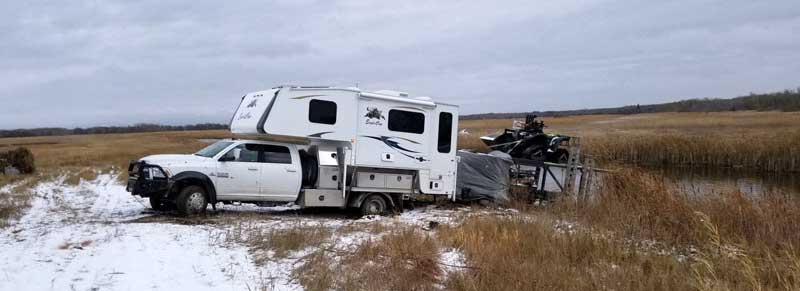
Above: Northern Manitoba
“I spend six to eight weeks in Northern Manitoba, usually up around The Pas area. I go there for the duck and grouse hunting as well as the fishing. Where I stay can vary greatly depending on where the ducks are located. It’s great to get out and have a vast area all to myself.
Even though my camper holds a good amount of water, I carry extra water jugs. I bring extra fuel to run boats and ATVs. I also utilize a satellite phone. I have a model that is able to send text messages so that’s a big help.
I installed a remote antenna on the roof so I can leave the sat phone on inside the camper and receive text messages from home at any time without burning much airtime. And yes, a big winch and chainsaw are a must. A shovel is nice too.
I’ve been stuck a few times. It’s always been just a matter of time for recovery operations. The picture above shows my snowy mud stuck rig at a ‘boat ramp’. Nothing that a little digging and winching can’t fix.
Have some communication of some sort. Have redundant systems. Something always breaks, especially when used hard. Have back-ups, ie, a come-along works after the winch burns up. The axe works after the chainsaw quits.
Just being remote is a great experience. Yes, I have a comfortable camper, but it’s great fun being out on your own and self-contained.” – Darin Leveraus, 2017 Ram 4500, Eagle Cap 1165
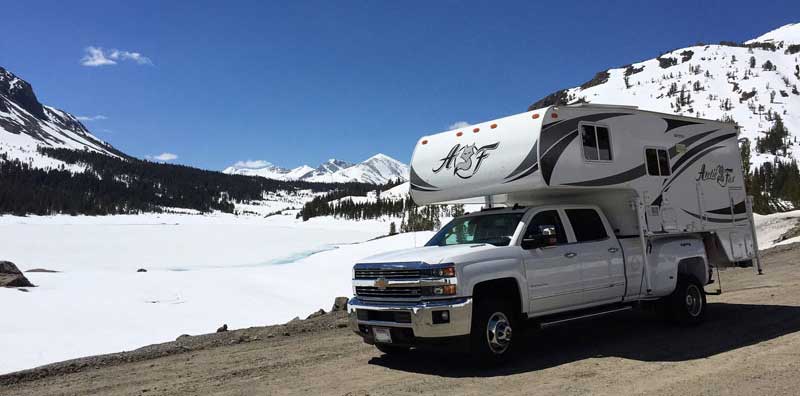
Above: Tioga Lake, just east of the Yosemite National Park entrance
“I like to head up to the Sierra Crest area for about a week and do this several times during the summer when I can access the area.
I love to have a basecamp where I can bring the dogs and my hiking and fishing gear. Then I head up on day trips from there to explore. Beautiful high peaks and hidden lakes that are rarely visited are what draw me to this area.
My rig is pretty much ready to go. I just need to stock the fridge, fine-tune the clothes layering for the weather and throw in the dog food.
Even though I am beyond cell reception, I check in twice a day via my Garmin inReach Mini via a short email or text. My contacts also check in with me. I’ve been snowed in for a delayed return and have had a fire block my intended road home for a while, but was able to let folks know about it so they wouldn’t send out a search party.
“I’ve been snowed in for a delayed return and have had a fire block my intended road home for a while, but was able to let folks know about it so they wouldn’t send out a search party.”
I have a Garmin InReach Mini that is paired with my iPhone. I check my messages and send an update each morning and evening. I also check the weather via the Mini.
I am surrounded by quiet and beautiful peaks, sunsets, and alpenglow. Hiking and fishing are a wonderful adventure but holing up in the camper during a thunderstorm with a good book is also a thing to look forward to.” – Candace Gregory, 2015 Chevrolet 3500HD, 2016 Arctic Fox 1150
“I’m often beyond cell service on public lands of the west. Pull down a dirt road in Utah and the call service will likely go away. No need to expound on where; the internet has already done that. Darn. No cell helps to keep some people out.
I don’t have anything special. Just a stock truck and camper. I bring plenty of water as that is in short supply in the desert. A flat tire, getting stuck, a dead truck battery… it’s all part of the stuff that turns a trip into an adventure. I go fishing, camping, wildlife, and regenerating my soul. This happens often.
If you go, I suggest being as self-reliant as you are capable of. Most of the places I go aren’t so far out that someone wouldn’t come by occasionally if I needed help. Certainly, bring enough food and water and tell someone where you are going. That’s just part of the ten essentials of the backcountry. I enjoy the solitude.” – Bruce Norring, 2004 Silverado, 2004 Hallmark Guanella
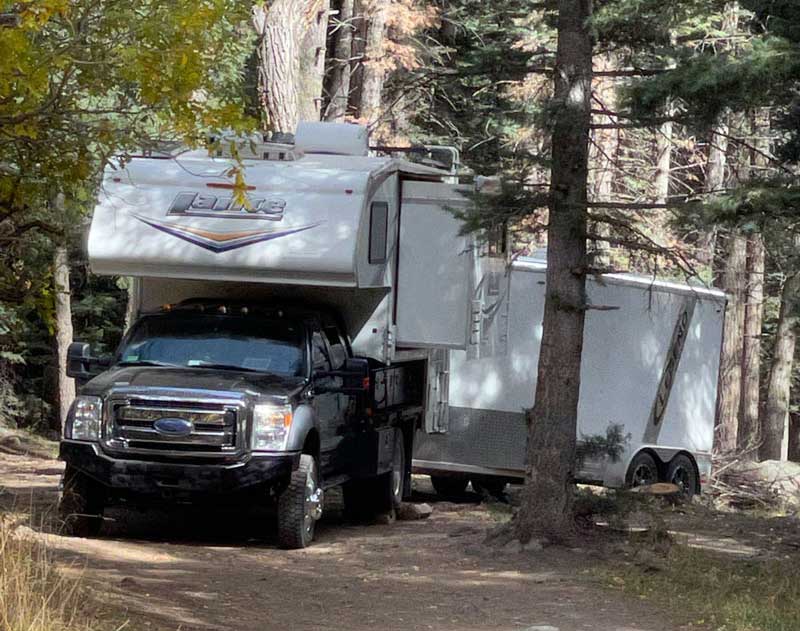
Above: The mountains in Colorado
“We often camp in remote locations where there is no cell service or very poor cell service. We live in the mountains in Colorado where cell service even at our house is poor. A lot of times we are in canyons where service is nonexistent. Other times we are out in the desert in Utah or Colorado.
We mostly dry camp and don’t miss the phones or tablets. That’s one thing we appreciate about our truck camper. We can get away from those devices.
We like to explore remote places. We search Google Maps for the most remote places we can find. Sometimes it is too difficult of terrain for our rig. So we compromise with an easier spot to access. We also usually bring our side-by-side UTV or dirt bikes to scout an area for good camping spots.
I have been a mechanic for 40 years and keep our truck in good shape. We do carry a Garmin InReach GPS that we can use to text via satellite service if we were to have any severe problems. Usually, it is to give directions to friends trying to find us out in the boonies. We have aggressive tires, carry tire chains, pack shovels, and have recently added a winch to the front of our truck.
We once had the turbo go out on our diesel in a remote area in Colorado. We had to run in limp mode at about 20-miles per hour for a couple of hours to get out of the remote area and get cell signal.
We always have plenty of provisions like food and water. We also take the Garmin InReach with us so we can contact someone in an emergency if needed. It is also imperative to know your truck and keep it in good repair and maintained. With our UTV or motorcycle, we always have a way to travel if the truck ever broke down.
We love to hike and ride our UTV and explore. The beautiful places, wildlife, and remote fishing spots keep us going back.” – Joe Calleja, 2012 Ford F-550, 2015 Lance 1172
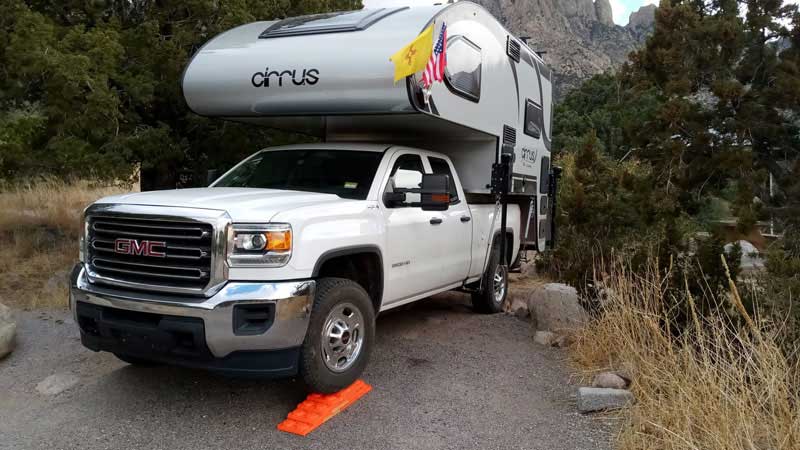
“What’s better than a week without being connected? Camping and not having service is an unexpected pleasure. I go camping in the Bureau of Land Management, state and national forest areas (thank you, America). Lately, we have been exploring New Mexico. Previously we explored West Virginia.
I take plenty of food, water, and other essentials. You have to be careful about injuries if you are alone. It pays to have some sort of protection, let someone know where you are going to be, and update him/her when you get back to service. Sometimes, unfortunately, someone will pull in and park close enough to be seen and heard. Otherwise, I have never had any problems.” – Carl Ragland, 2019 GMC, 2021 Cirrus 820
“Our adventure occurred in the middle of nowhere in the Red Desert of southwest Wyoming.”
“My story goes back in history quite a ways; probably about 45-years when there were no cell phones. Our adventure occurred in the middle of nowhere in the Red Desert of southwest Wyoming. My husband, Glen, and I, along with our five year old daughter, Karen, and our black Lab, Cinder, took a trip in our 1966 Red Dale camper mounted on a 1966 Dodge Power Wagon.
We had been seeking an elusive spot on the maps identified as Pickett Lake and so far, had been unsuccessful in getting there. This trip left from Rock Springs and headed east by northeast. All went well until we crossed a wide alkali wash somewhere way north of Wamsutter. The wash was damp (it was raining) and it did what all alkali does; just sucked us down.
The rain continued, and we were stuck, and there was nothing to winch to. So we just settled down, fixed dinner, and went to bed. The next morning the water was up to the tailgate. Glen set out walking back south to find help and met a seismograph crew with four vehicles. We hooked all of them together to our outfit and got pulled out.
Be prepared to stay awhile if you have a problem. It’s better to be lucky than good!” – Judy Zumwalt, 1965 Dodge Power Wagon, 1966 Red Dale
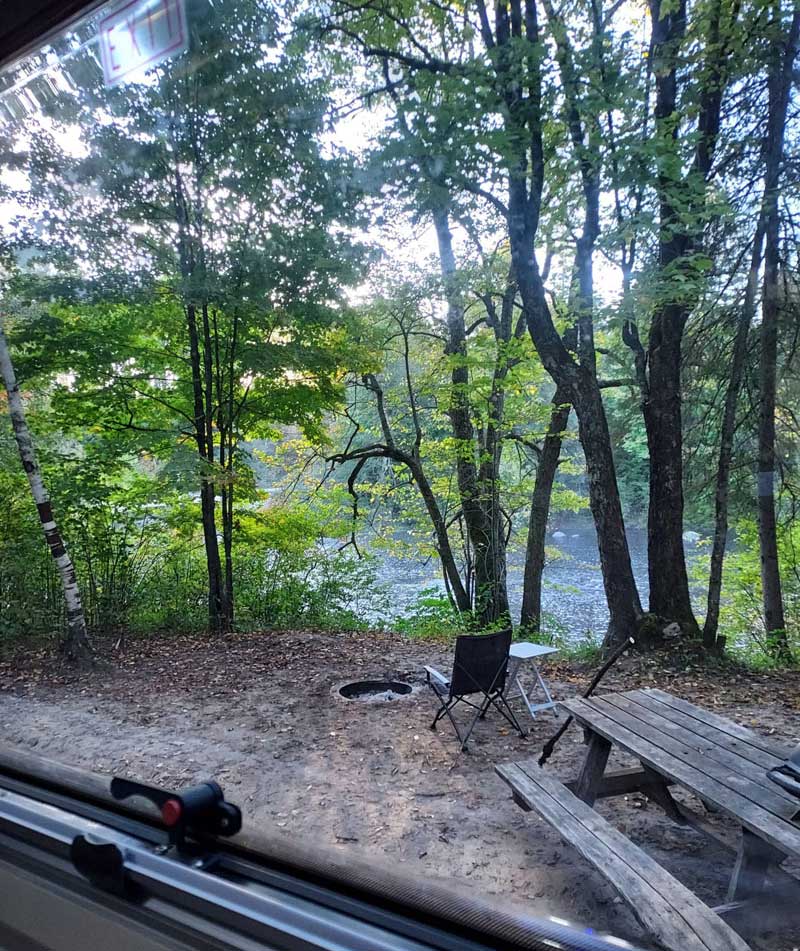
“In the picture above we are camped alongside the beautiful Peshtigo River in northern Wisconsin. This location is close to our house, along the water and away from people.
My rig is always ready to go. My advice is to let someone know where you’re going. I go back so that I can be alone.” – Randy Stanczak, 2022 Ford F250, 2017 Cirrus 820
“We were without cell service for a week on two trips in 2021; Big Bend National Park in Texas, and Roaring River State Park/Eureka Springs in Missouri.
Big Bend was expected. And yes, we could have broken camp and driven about 30 to 45-minutes to make a call, but we had no reason to do that. We just used our ZOLEO satellite communicator to check in with family and friends. Cell service is sketchy in many parts of west Texas, so we just plan on not having it.
Roaring River/Eureka Springs was a surprise. There was no Sprint/T-Mobile service for literally 100-miles around the area. It’s a great area and worth a visit. Some carriers obviously worked. But we had zip for cell service for a week and again used the ZOLEO to stay connected and for emergencies.
We prefer to be off the beaten path. We don’t intentionally search out off-grid locations but are good if that’s the case. Big Bend is a beautiful natural area, Roaring River/Eureka Springs is a quiet and pretty destination as well.
Our rig is ready to go where we want to go. I would like to add a weBoost cell booster for the marginal cell service areas, and/or replace the pointless satellite and install Starlink satellite internet when it is ready.
ZOLEO satellite messages are different than text messages which are essentially free. Satellite messages regardless of the provider cost a heck of a lot more and are limited in number and length. Explaining that to a twenty-something while on the ZOLEO and off-grid was interesting.
A cell booster doesn’t work where there isn’t any cell service to boost, so you need a Plan B. Being out of cell service is just what we do.” – Larry Ford, 2016 GMC 3500HD Denali, 2018 Lance 1172
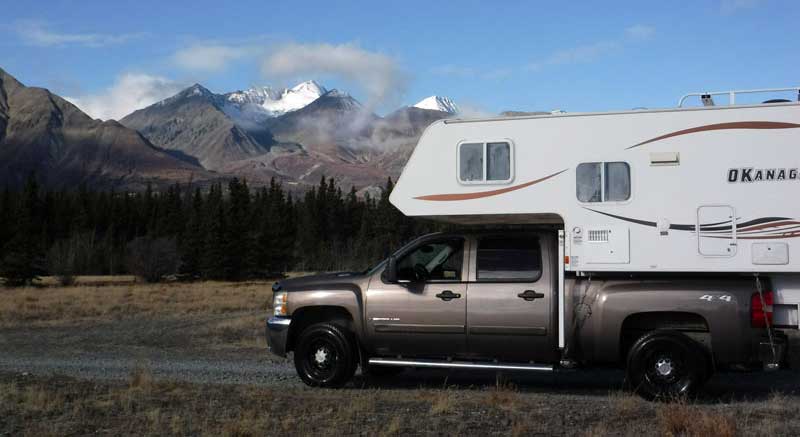
Above: Alsek Valley, Kluane Region, Yukon
“Living in the Yukon Territory and enjoying this vast and beautiful land year-round, we often are beyond cell service. For us, not having cell services in remote areas is not an issue at all when we explore the Yukon. You can get service in the communities and villages.
The Yukon gives you so many opportunities to enjoy life with its landscape, mountains, lakes, and rivers and, not to forget, the people who live on this land. That is the main reason why we still go and discover this unique place even after all the years we have lived here.
“The Yukon gives you so many opportunities to enjoy life with its landscape, mountains, lakes, and rivers and, not to forget, the people who live on this land.”
With our camper, we can boondock for ten to twelve days without returning to civilization. We modified our camper for our needs with a 100-watt solar panel, two Group 31 batteries, a porta-potty, and seventeen gallons of fresh water. If we need more water, lakes and rivers are always close.
The truck is equipped with gears for self-recovery. Finally, in case of emergency, we always bring with us our Garmin InReach device. Our friends and family know where we are and we can communicate with them if something goes wrong.
For safety matters, I would say to contact someone to share your plan before going, even if you have a satellite communication device.” – Roch Nadon, 2008, Chevy 2500 HD, 2007, Okanagan 89WS
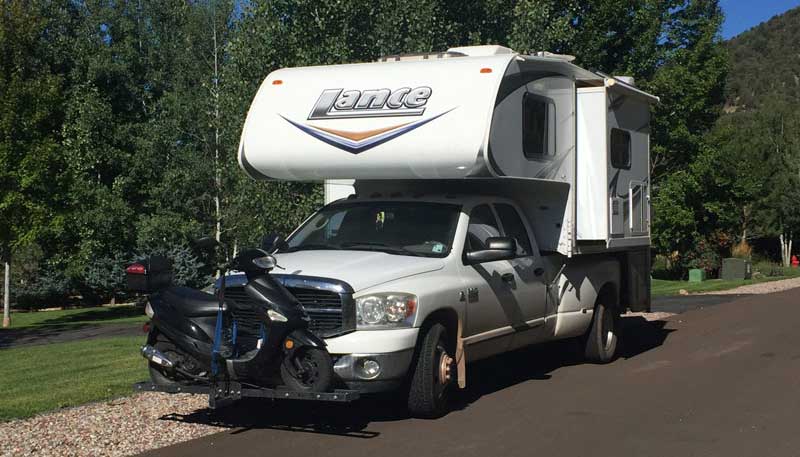
“I enjoy great fishing, solitude, silence, and the self-sufficiency of camping. Before I retired as a school principal, I intentionally sought out places beyond cell service so I could relax during my short summers. There were times when I spent seventeen consecutive days in Montana without cell service, and sometimes without seeing another camper.
Nowadays I am much more concerned with wildfires than packs of organized prairie dogs! Many of those places that were out of cell phone range now have cell service. With satellite TV and cell service, I can keep an eye for potential fire and high wind danger and move around appropriately.
When I go out, I have a full water tank, a full refrigerator, and full propane. Solar panels provide all the electricity I need so I have never had or needed a generator.
Many years ago, my grandmother died while I was in Montana beyond cell service. By the time I got the news, it was too late for me to get to her funeral.
Given the increasing severity and frequency of terrible fires, I would make sure I had an alternate path out of the area. Don’t go into an area in which you could be trapped with no way out.” – Phil B., 2007 Ram 3500, 2012 Lance 992
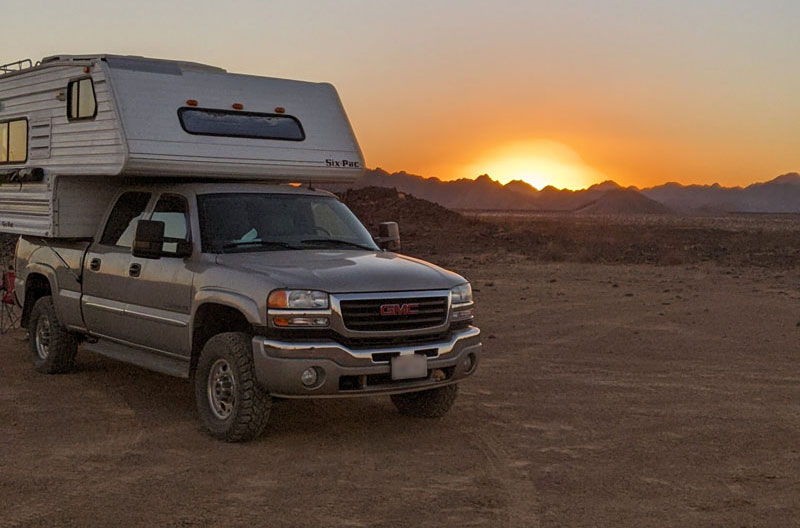
Above: El Camino del Diablo
“The El Camino del Diablo road is beyond cell service. The photograph above shows part of a three-week shake-down trip with our then new-to-us truck camper.
We have been as remote with our travel trailer in the past including the Robert Campbell Highway in the Yukon and the Denali Highway. All three are good entry-level remote tracks as someone will drive by eventually if something goes wrong.
To be prepared beyond basic maintenance on my truck, I have added a new fuel pump, new batteries, a Mechman alternator, new shocks, full-size tires, a Hellwig Bigwig sway bar, a DC fridge in my truck, a DC-to-DC charge controller for the camper, Satellite radio, a water transfer pump for a five-gallon container, and a 45-gallon fuel tank.
For the camper, I have added a Lithium battery, DC refrigerator, solar, a separate toilet, a diesel heater, two diesel spare fuel tanks, and a Rotopax for gasoline.
We use a Verizon Jetpack and our phones are on T-Mobile with WIFI calling. This helps expand our cell range. In addition, we have a ZOLEO satellite messaging device.
The people you run across are like-minded; sharing road conditions, points of interest, and hometowns. It’s enjoyable.
“The people you run across are like-minded; sharing road conditions, points of interest, and hometowns. It’s enjoyable.”
Before we go, we have the route downloaded on Gaia and we inform our contacts of our itinerary. We update them with the satellite messenger when we start the track (with GPS location) and send check-ins each evening along the track.
We bring enough food and water for at least 50-percent more time than we are remote. In areas with water we have a filter but, in the desert, we keep one or two five-gallon containers of water in case there is an issue with a system in the camper. This is all in preparation for more remote single-vehicle travel. The learning continues.
I keep going out beyond cell service to be alone and to experience vast expanses of nature without seeing or hearing people. We enjoy being in isolated, rugged and beautiful country in relative comfort.” – Craig Toutolmin, 2005 GMC 2500 HD, 2002 Six-Pac
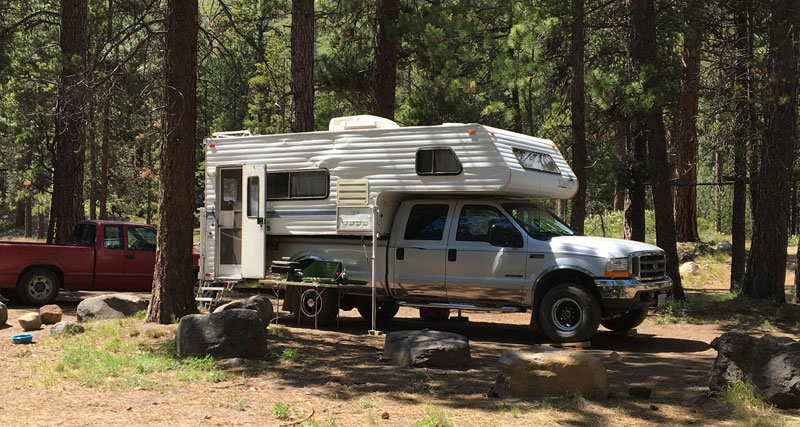
Above: Deschutes National Forest
“My wife and I like to go dry camping in the Deschutes National Forest in Oregon. It’s only an hour and a half away from where we live. It’s a beautiful area that has multiple lakes, rivers, and streams. There are hundreds of places to camp in Oregon’s forests that are beautiful and free.
“There are hundreds of places to camp in Oregon’s forests that are beautiful and free.”
My camper is always ready to go. I fill up my 2,000-watt generator, fill the camper with water and load up our Jeep Wrangler with a table, chairs, and barbecue and we’re on our way. My advice would be to go out between Monday and Friday if you can. Being beyond cell service is good. We stop getting robocalls and stupid text messages all day. Going beyond cell service is also free and there are very few people.” – Mike Dueno, Ford 2001 F-350, 1994 Elkhorn 11X
“We went to Labrador on a road trip and James Bay on a fishing trip. There was no cell service during most of that trip. We love quiet places, to be on our own. We always bring enough water, have our 100-watts of solar, and a good battery. Camping beyond the reaches of cell service is relaxing, and we enjoy nature.” – Patrice Boucher, 2014 Ram 3500, 2019 Northern Lite 9.6
“I go to the Owhyees in Idaho. It’s a nice quiet break from town life, and there’s no cell service. I go hunting and fishing as well as just exploring an area that others stay away from. It makes it more peaceful.
I run a stock truck with slightly bigger-than-stock wheels and I upgraded the shocks. I always make sure to bring plenty of food and water; normally two days of extra food and an extra five-gallon water container. The other thing I always keep is extra fluids for the truck and a few common parts. I always prepare for the unexpected.
Flat tires happen and sometimes in the worst places. It has happened to me many times. Last year my truck overheated. About 20-miles from nowhere I had to deal with that. It turns out it was not as bad as it could have been, but nonetheless, that made me stop for several hours.
I recommend that you bring extras of everything because breakdowns happen. I enjoy the tranquility, the peace and quiet, and the fact that I know there is no one is around to deal with.” – Kristian Lewis, 2000 Silverado 1500, More of a Cowboy camo
